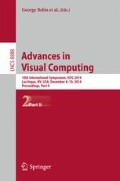Abstract
This paper presents a novel tracking method based on Kanade-Lucas-Tomasi(KLT) for Markerless Augmented Reality system. Two main contributions are listed as follow: 1) feature points are tracked in a multi-level image pyramid model and the tracked points on different levels are blended together; 2) tracked points are refined using the geometric structure between them, including wiping off fictitious points and recovering missing points. In addition,it adapts to acute scale variation and poor quality image tracking. Experimental results show that the proposed algorithm is robust to scale invariant and the re-projection error of feature points on each frame is smaller than one pixel, which is kept at sub-pixel.
Access this chapter
Tax calculation will be finalised at checkout
Purchases are for personal use only
Preview
Unable to display preview. Download preview PDF.
References
Bergamasco, F., Albarelli, A., Rodola, E., Torsello, A.: Rune-tag: A high accuracy fiducial marker with strong occlusion resilience. In: 2011 IEEE Conference on Computer Vision and Pattern Recognition (CVPR), pp. 113–120. IEEE (2011)
Uchiyama, H., Saito, H.: Random dot markers. In: 2011 IEEE Virtual Reality Conference (VR), (2011) 35–38. IEEE (2011)
Uchiyama, H., Marchand, E., et al.: Object detection and pose tracking for augmented reality: Recent approaches. In: 18th Korea-Japan Joint Workshop on Frontiers of Computer Vision (FCV) (2012)
Van Krevelen, D., Poelman, R.: A survey of augmented reality technologies, applications and limitations. International Journal of Virtual Reality 9, 1 (2010)
Lowe, D.G.: Distinctive image features from scale-invariant keypoints. International Journal of Computer Vision 60, 91–110 (2004)
Bay, H., Tuytelaars, T., Van Gool, L.: SURF: Speeded up robust features. In: Leonardis, A., Bischof, H., Pinz, A. (eds.) ECCV 2006, Part I. LNCS, vol. 3951, pp. 404–417. Springer, Heidelberg (2006)
Rosten, E., Drummond, T.: Machine learning for high-speed corner detection. In: Leonardis, A., Bischof, H., Pinz, A. (eds.) ECCV 2006, Part I. LNCS, vol. 3951, pp. 430–443. Springer, Heidelberg (2006)
Baker, S., Matthews, I.: Lucas-kanade 20 years on: A unifying framework. International Journal of Computer Vision 56, 221–255 (2004)
Bouguet, J.Y.: Pyramidal implementation of the affine lucas kanade feature tracker description of the algorithm. Intel Corporation 5 (2001)
Shi, J., Tomasi, C.: Good features to track. In: Proceedings of 1994 IEEE Computer Society Conference on Computer Vision and Pattern Recognition, CVPR 1994, pp. 593–600. IEEE (1994)
Fischler, M.A., Bolles, R.C.: Random sample consensus: a paradigm for model fitting with applications to image analysis and automated cartography. Communications of the ACM 24, 381–395 (1981)
Rublee, E., Rabaud, V., Konolige, K., Bradski, G.: Orb: an efficient alternative to sift or surf. In: 2011 IEEE International Conference on Computer Vision (ICCV), pp. 2564–2571. IEEE (2011)
Author information
Authors and Affiliations
Editor information
Editors and Affiliations
Rights and permissions
Copyright information
© 2014 Springer International Publishing Switzerland
About this paper
Cite this paper
Fan, C., Zhao, Y., Feng, L. (2014). Markerless Planar Tracking in Augmented Reality Using Geometric Structure. In: Bebis, G., et al. Advances in Visual Computing. ISVC 2014. Lecture Notes in Computer Science, vol 8888. Springer, Cham. https://doi.org/10.1007/978-3-319-14364-4_33
Download citation
DOI: https://doi.org/10.1007/978-3-319-14364-4_33
Publisher Name: Springer, Cham
Print ISBN: 978-3-319-14363-7
Online ISBN: 978-3-319-14364-4
eBook Packages: Computer ScienceComputer Science (R0)

